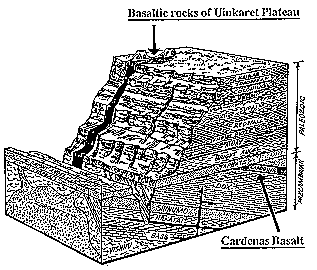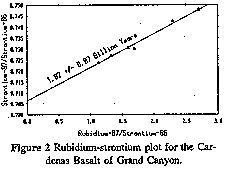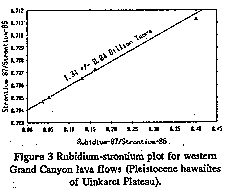Everyone has heard about the great ages claimed by evolutionists for the earth's rocks. This is particularly true of Grand Canyon rocks. Television documentaries, textbooks, and museum displays tell us that the deepest rock layers within Grand Canyon are more than one billion years old. The same evolutionary sources tell us that the most recent rocks of Grand Canyon are just thousands of years old. The great thickness of strata in Grand Canyon is supposed to span "geologic ages" representing many hundreds of millions of years.
Have these claims of hundreds of millions of years with Grand Canyon strata been verified? Do radioactive isotope dating methods provide convincing evidence for billion-year-old rocks?
During the last four years, the Institute for Creation Research has undertaken a research project to test the "ages" assigned by the best radioactive isotope dating methods to Grand Canyon rocks. This research has been called the "Grand Canyon Dating Project." A preliminary analysis of the data and methods for dating Grand Canyon rocks was published in ICR's Impact No. 178, "Grand Canyon Lava Flows: A Survey of Isotope Dating Methods."1 Since that publication, research has focused on the isotope compositions of Grand Canyon lava flows. New analyses of Grand Canyon rocks allow the popular rubidium-strontium isochron method to be evaluated.
Grand Canyon Lava Flows
Two lava-flow formations occur in the Grand Canyon: the Cardenas Basalt and the western Grand Canyon lava flows. Both formations are shown in Figure 1. Both are basalts, and both should be ideal for radioactive isotope dating. For these reasons, these formations were selected for radioactive isosope dating by the rubidium-strontium isochron technique.

Figure 1. Block diagram of Grand Canyon showing the Cardenas Basalt and the western Grand Canyon lava flows.
The deeply buried Cardenas Basalt occurs among the oldest strata of Grand Canyon. This basalt has been assigned to the Precambrian strata of the Unkar Group, which contains the lowest and hence oldest strata of the Grand Canyon. Some geologists have suggested an "age" of more than one billion years.
The western Grand Canyon lava flows are among the youngest formations of the Grand Canyon. The youngest flows came from volcanoes on the Uinkaret Plateau north of the Colorado River. Some of the lava flowed over the north rim, cascading into Grand Canyon, forming spectacular "frozen" lava falls. Several lava flows even reached the river, forming lava dams. Although no Indian legends attribute them to recent eruptions, one early geologist remarked about the extraordinary freshness of the lava: "It looks as fresh as any coulee of Vesuvius ejected twenty or thirty years ago." 2 One K-Ar "model age" determination gave 1.2 + 0.2 million years for the lava dam, 3 and geologists consider these lava flows to be Pleistocene in age.
Rubidium-Strontium Data
Rubidium, a trace element which is chemically similar to potassium, is naturally radioactive. Twenty-eight percent of rubidium atoms are the isotope rubidium-87 (87Rb). It decays to strontium-87 (87Sr), which is a common, stable isotope of strontium. The radioactive decay of rubidium is slow, and would require 48.8 billion years 4 for half the 87Rb of a rock to be converted to 87Sr. Evolutionary geologists have suggested that the isotope ratios of 87Rb to 87Sr in rocks can be used to determine "ages" in hundreds of millions, even billions of years.
 Figures 2 and 3 show isotope ratios of rubidium and strontium in the two basaltic lava flow units of Grand Canyon. Figure 2 shows the isotope ratios of six rock samples from the Cardenas Basalt. These analyses were determined by E. H. McKee and D. C. Noble, two geologists working with support from the U.S. Geological Survey, National Science Foundation, and National Aeronautics and Space Administration. 5 The fact that the data seem to describe a line on the plot of 87Sr/86Sr versus 87Rb/86Sr, is thought to testify to the validity of the method and the suitability of the specimens, and thus the basalt was given an "age" interpretation by the two geologists. They reasoned that the Cardenas Basalt issued from a volcano or volcanoes which originally had lavas with a common ratio of strontium isotopes.
Figures 2 and 3 show isotope ratios of rubidium and strontium in the two basaltic lava flow units of Grand Canyon. Figure 2 shows the isotope ratios of six rock samples from the Cardenas Basalt. These analyses were determined by E. H. McKee and D. C. Noble, two geologists working with support from the U.S. Geological Survey, National Science Foundation, and National Aeronautics and Space Administration. 5 The fact that the data seem to describe a line on the plot of 87Sr/86Sr versus 87Rb/86Sr, is thought to testify to the validity of the method and the suitability of the specimens, and thus the basalt was given an "age" interpretation by the two geologists. They reasoned that the Cardenas Basalt issued from a volcano or volcanoes which originally had lavas with a common ratio of strontium isotopes.

The original ratio of 87Sr to 86Sr of Cardenas Basalt was believed to be 0.7065. According to the "age" interpretation, those samples of Cardenas Basalt with higher 87Rb have, over a very long period of time, acquired a large quantity of 87Sr by radioactive decay of 87Rb. The quantity of 86Sr is not affected by radioactive decay, and it stays constant. A simple calculation employed by these geologists indicates that 1.07 + 0.07 billion years would be required for the rock samples to acquire their various strontium isotope ratios by rubidium decayed. 6 That "age" of 1.07 billion years is the "rubidium-strontium isochron age" of the Cardenas Basalt, and is widely regarded by evolutionists as the best age obtained for Grand Canyon Rocks.
Figure 3 shows the isotope ratios obtained for basaltic lava flows from the western Grand Canyon. The isotope ratios are from hawaiite lava flows from the Uinkaret Plateau on the north rim of Grand Canyon. Four whole rock samples and one feldspar sample separated from one of the whole rock samples were submitted independently to three different laboratories for testing. These data were obtained by the author, of the Institute for Creation Research, with private-donor support and the assistance of the three analytical laboratories.
The data in Figure 3 also show a linear trend on the 87Sr/86Sr versus 87Rb/86Sr plot. There is a distinct slope to the line, which is unexpected. We might suppose that these recent lava flows on the north rim of Grand Canyon would be homogeneous with respect to strontium isotopes. All the rocks should have about the same strontium isotope, ratios. Instead, we note that lava flows having higher 87Rb also have higher 87Sr. The abundances vary in a linear fashion. It would appear that an "age" relationship is suggested by the linear plot of Figure 3. Indeed, the same equation used to date the Cardenas Basalt at 1.07 billion years gives an "age" of 1.34 ± 0.04 billion years for these recent lava flows of western Grand Canyon. That is even older than the Cardenas Basalt!
Old "Ages" for Young Lava Flows
The observation that obviously recent lava flows from the north rim of Grand Canyon give ages even older than the deeply buried lava flows, challenges the basic assumptions upon which the isochron dating method is based. The discovery of an "old age" in an obviously "young" series of lava flows has encouraged further research at ICR. Has the Cardenas Basalt been successfully dated? An intense isotope, trace element, and rare earth element analysis is now underway at ICR. 7 Some extraordinary relationships are becoming apparent. These recent lava flows are being tested by the most sophisticated analytical techniques, to determine the best explanation for the excessively old "age." The same methods are also being applied to the deeply buried lava flows of Grand Canyon. We might ask, "Has anyone successfully dated a Grand Canyon rock?"
This research is being conducted by Dr. Steven A. Austin, at the Institute for Creation Research. A brochure describing the "Grand Canyon Dating Project" is available upon request. This ongoing research is being supported by donations from private individuals. These gifts are tax-deductible, and should be designated for the "Grand Canyon Dating Project." This project has been funded without grants from taxpayer-supported government agencies.
REFERENCES
[1] Steven A. Austin, "Grand Canyon Lava Flows: A Survey of Isotope Dating Methods," Institute for Creation Research Impact No. 178, April 1988, 4 pp.
[2] C. E. Dutton, "The Tertiary History of the Grand Canyon District," U.S. Geological Survey Monograph 2 (1882):111.
[3] E. D. McKee, W. K. Hamblin, and P. E. Damon, "K-Ar Age of Lava Dam in the Grand Canyon," Geological Society of America Bulletin, 79 (January 1968): 133-136.
[4] Gunter Faure, Principles of Isotope Geology (New York: John Wiley & Sons, 2nd edition, 1986), p. 119.
[5] E.D. McKee and D. C. Noble, "Age of the Cardenas Lavas, Grand Canyon, Arizona," Geological Society of America Bulletin, 87 (August 1976):1188-1190.
[6] Ibid. The "age" has been recalculated, using the new decay constant for rubidium-87.
[7] A technical report describing the progress of the "Grand Canyon Dating Project" is being prepared by Dr. Austin. This report will contain the data and description of rocks being studied.
* At time of publication, Dr. Steven A. Austin was Chairman of the Geology Department of ICR and directed the "Grand Canyon Dating Project."
Cite this article: Austin, S. A. 1992. Excessively Old "Ages" for Grand Canyon Lava Flows. Acts & Facts. 21 (2).













